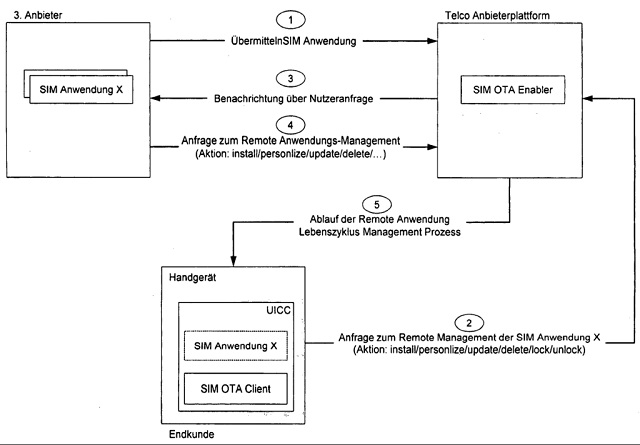This decision concerns the way how applications can be installed on a mobile phone's SIM, One might not expect big surprises concerning the technical character in this field, but the board took a stricter view in this case.
Here are the practical takeaways from the decision T 1310/17 (Anwendungen auf SIM-Karten/TELEKOM) of 11.11.2020 of Technical Board of Appeal 3.5.03:
Key takeaways
Providing the SIM OTA Enabler as a server system in the network provider's network relates to administrative processes or administrative considerations rather than technical considerations.
The invention
This is an opposition appeal. The European patent concerns the way how applications are loaded onto the SIM card in a mobile phone (so-called "provisioning"). In the prior art, the provisioning is done either locally via the SIM card's contacts and a card reader, or remotely via GSM/UMTS or a similar wireless interface (so-called "over the air" or "OTA" provisioning).
According to the patent, a drawback of the prior art is that the (OTA) provisioning is controlled by the network operator, so that third parties have only limited capabilities of equipping a SIM card with application software. It is therefore the problem addressed by the patent to open up the internal process of the network provider such that third parties can install their apps on the SIM cards of the network provider's customers.

Fig. 1 of EP 2 451 135
Here is how the invention was defined in claim 1:
Claim 1 in amended form (English translation by the author of this article)
A method for the individual provisioning of applications in a mobile terminal, which has a SIM card on which the applications can be stored and executed, with a SIM OTA Enabler provided by the network operator as a server system in the network of the network operator which has access (1) to applications that can be stored and executed on the SIM card, comprising the following steps:
-a third-party provider transmits a SIM Java application to the SIM OTA Enabler (1):
– sending an application request (4) (2) to the SIM OTA Enabler by a user of a SIM card to download an application, wherein an identification of the SIM card and the application is transmitted;
– verifying that the application request is admissible based on a set of rules by the SIM OTA Enabler,
wherein the third-party provider needs an authorization, in particular certificates, user identifiers and passwords, to authenticate itself to the SIM OTA Enabler to ensure that only applications that have successfully passed the required security checks and that come only from third-party vendors that have been checked are transmitted to the mobile terminal, and in case of admissibility
– accessing the application via the SIM OTA Enabler and transmitting the application via OTA (5) to the SIM of the mobile terminal,
– wherein after receiving an application request, an information is sent to the third-party provider of the application which initializes, personalizes, deletes and/or updates (4) the application via messages that are transmitted to the SIM OTA Enabler and forwarded by it to the SIM of the mobile terminal.
Is it patentable?
In this opposition case, the opposition division had maintained the patent only in amended for according to auxiliary request 1. An appeal was filed by the opponent only.
On the opposition appeal stage, the board based its inventive-step analysis on a prior art document that already disclosed the concept of individualized application provision by a SIM OTA Enabler.
In its analysis of the differences of the claimed method over the prior art, the board discussed whether the prior art anticipates the "forwarding" of messages to the SIM. Interestingly, the board took quite a broad interpretation of what it means to "forward" a message, which seems to rely of the board's general understanding of the subject-matter without reference to the patent or the common general knowledge of the skilled person (all citations are translations of the German decision):
According to point 10.3 of the grounds of the appealed decision, the opposition division took the view that the "TSM" in D7 would not forward messages but would rather generate own "Perso commands" from the "Perso Data". The forwarding of the messages would mean that the message "Ack (Perso Data)" of block 7 would have to be provided unchangedly to the SIM of the mobile terminal. Instead, the TSM of D7 unpacks the data "Perso Data" of the "Ack" message and generates different commands based on the data, which commands are then provided to the SIM of the mobile terminal. Thus, feature b4) was not disclosed in D7.
This cannot be followed. The expression "message" in claim 1 does not imply a specific limitation with regards to the underlying data packet formats or transport protocols. As explained by the appellant on page 9 of the grounds of appeal, Fig. 11 of D7 shows a forwarding by way of a bent arrow, which is the case despite a possible reformatting of the "Perso Data".
As a result, according to the board the only difference over the closest prior art was that the SIM OTA Enabler is provided by the network provider as a server system in the network of the network provider (feature b), and that the application request is sent to the SIM OTA Enabler by a user of a SIM card (feature b2).
On the one hand, the board acknowledged that the effects of these features are expressly explained in par. [0021] of the patent. There, it is explained that the invention has "the following advantages over existing solutions":
- The OTA provisioning of Javacard applications is opened to third-party providers – without having to rely on an intermediary in the sense of a Trusted Service Manager.
- The customer can trigger the provisioning of SIM-based Java applications him/herself.
- The solution can be integrated seamlessly in existing enabler platforms of the network provider.
However, the board took the view that these effects were not technical effects, but rather administrative ones:
These advantages, however, relate to administrative processes or administrative considerations rather than technical considerations. Since the distinguishing features thus do not affect technical aspects, they are taken as requirements to be fulfilled in the formulation of the objective technical problem (see T 641/00, OJ 2003, 352, Headnote II).
Therefore, the objective technical problem can be formulated ... as the "implementation of a SIM/SE platform which is easier to employ on the market, i.e. the implementation of an "open ecosystem" within the network of D7, so that the network provider can provide and bill for additional services by means of the increased control over the customer. A motivation solely based on technical considerations cannot be seen.
In the end, the claimed solution was considered obvious. In the absence of additional requests on file, the patent was revoked in its entirety.
The content of this article is intended to provide a general guide to the subject matter. Specialist advice should be sought about your specific circumstances.

